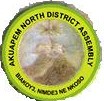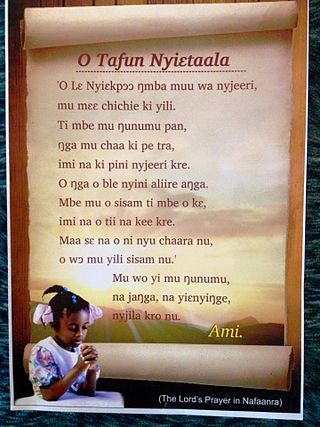Related Research Articles

The Akyem are an Akan people. The term Akyem is used to describe a group of four states: Asante Akyem, Akyem Abuakwa, Akyem Kotoku and Akyem Bosome. These nations are located primarily in the eastern region in south Ghana. The term is also used to describe the general area where the Akyem ethnic group clusters. The Akyem ethnic group make up between 3-4 percent of Ghana's population depending on how one defines the group and are very prominent in all aspects of Ghanaian life. The Akyem are a matrilineal people. The history of this ethnic group is that of brave warriors who managed to create a thriving often influential and relatively independent state within modern-day Ghana. When one talks of Ghanaian history, there is often mention of The Big Six. These were six individuals who played a big role in the independence of Ghana. Of the big six, people of Akyem descent made up the majority.

Akropong is a town in South Ghana and is the capital of the Akuapim North District, a district in the Eastern Region of South Ghana. This town is known for producing snails and palm oil. Akropong has a 2013 settlement population of 13,785 people.
The Akan people appear to have used a traditional system of timekeeping based on a six-day week. The Gregorian seven-day week is known as nnawɔtwe (eight-days). The combination of these two system resulted in periods of 40 days, known as adaduanan.
Adukrom is a town in the Okere District Assembly in the Eastern Region of Ghana. It shares borders with Awukugua Akuapem where Okomfo anokye was born The town is known for the Nifahene Stool of Akuapem and the capital of Okere District and situated on the Togo Atakora hills on the main Ho-Koforidua main trunk road in the northern part of Akuapem.

The Akwasidae Festival is celebrated by the Ashanti people and chiefs in Ashanti, as well as the Ashanti diaspora. The festival is celebrated on a Sunday, once every six weeks.
Of the populated places in the Eastern region of Ghana, Larteh Akuapem is the capital of the Benkum Division of the Akuapem Traditional Council. It lies on the east of the ridge on the Akonnobepow.
Adae Kese Festival is an important albeit rare celebration among the Ashantis in Ghana. There are two main periods for this celebration: one is Awukudae, and the other is Akwasidae. It glorifies the achievements of the Asante kingdom. It was first celebrated to the achievement of statehood of the people, after the war that the Ashantis had their independence, in the Battle of Feyiase which they fought against the people of Denkyira. It is also the occasion when the purification ceremony of Odwira is performed at the burial shrines of ancestral spirits. Generally, this coincides with the harvest season of yam and hence the ritual was also called the "Yam custom" by Europeans. It is celebrated every two weeks by the people in accordance with the calendar of the Akans based on the cycle of forty-two days and nine months in their calendar. The festival is mostly held to climax celebrations of specific achievements and milestones of the people of the Ashanti kingdom. The festival is a day of rest so it is forbidden to work on that day.

Adae Festival is a celebration in Ashanti. Considered a day of rest, it is the most important ancestral custom of the Ashanti people.

Awukudae Festival (meaning: "Wednesday ceremony", is a traditional Ashanti festival in Ashanti. Like the Akwasidae Festival, celebrated on a Sunday, Awukudae is part of the celebrations within the Adae Festival cycle. The festivals of Adae are not interchangeable, having been fixed from ancient times.

Asogli Yam Festival is an annual festival celebrated by the people of Asogli in the Ho Municipality located in the Volta Region of Ghana. It is celebrated in September annually to celebrate the cultivation of yam that was started by a hunter who found the tuber in the forest during his hunting expedition.

Banda Ahenkro is a town located in the west-northern of Bono region, Ghana, near the border of Ivory Coast. Its geography provided a home for numerous groups seeking shelter from across West Africa during the slave trade era. The original name of the settlement was Serminakuu meaning groups of 'grasses'. This name was changed to Banda, which is a corruption of 'Woanda' meaning 'they did not sleep'. Ancestors of Banda Ahenkro were allies of the Asante kingdom during wars and they provided a military force that virtually refused to sleep during at-war times. This is because they were predominantly Muslims and were found praying throughout the night. Later, 'woanda' was also corrupted by the Bono neighbours to become Banda. The settlement evolved to become the chief town or 'Ahenkro' within a collection of Nafana communities.
Ohum Festival is a traditional festival celebrated by Akuapems and Akyems in the Eastern Region of Ghana.
Amanokrom is a town in the Akuapim North District of the Eastern Region of Ghana. It shares border with Mamfe and Abotakyi
Abiriw is a town in the Okere District Assembly in the Eastern Region of Ghana.It shares border with Akropong and Dawu.

The Christ Presbyterian Church, formerly known as the Basel Mission Church, Akropong, is a historic Protestant church located in Akropong–Akuapem, Ghana. It is the first Presbyterian Church to be established in Ghana. It was founded in 1835 by Andreas Riis, a Danish minister and missionary of the Basel Mission who was the only congregant at the time. After years of dormancy, the church began to flourish after the arrival of the Moravian missionaries from the West Indies in 1843. The Basel missionary, Johann Georg Widmann was appointed the minister-in-charge of the Akropong church in 1845. The Jamaican missionary, John Hall, who had served as an elder in his home church in Irwin Hill, Montego Bay, became the first Presbyter of the church while Alexander Worthy Clerk became the first Deacon. Liturgical services are conducted in English and the Twi language.

Oseadeeyo Kwasi Akuffo III is a Ghanaian traditional ruler who is the Omanhene of the Akuapem traditional area (Okuapeman) in Ghana. He is a member of the Eastern Region house of chiefs.
Mamfe is a town in the Akuapim North Municipal District of the Eastern Region of south Ghana. It shares borders with Amanokrom And Akropong
Kitase is a town in the Akuapim South Municipal District of the Eastern Region of south Ghana. It shares borders with Peduase which is one of the entry points from Accra to Akuapem.
Ahwerase is a town in the Akuapim South Municipal District of the Eastern Region of south Ghana. It shares borders with Aburi which is famous for the Aburi Botanical Gardens and the Odwira festival. The name 'Ahwerase' is an Akan language which translates to 'Under the sugarcane"
References
- ↑ "Odwira Festival" . Retrieved July 3, 2012.
- ↑ "The Odwira Story". Akropong Akuapem Odwira Festival. Retrieved 2020-11-05.
- ↑ "Okuapeman Odwira 2021: A Melting Point of Rich Culture and Tradition". theaccratimes.com. Retrieved 2023-09-14.
- ↑ "Okuapeman Odwira 2021: A Melting Point of Rich Culture and Tradition". theaccratimes.com. Retrieved 2023-09-14.
- ↑ "All the rich rituals you missed at the 2021 Odwira Festival". ghanaweb.com. Retrieved 2023-09-14.